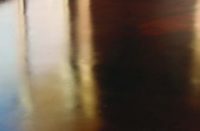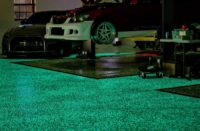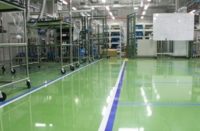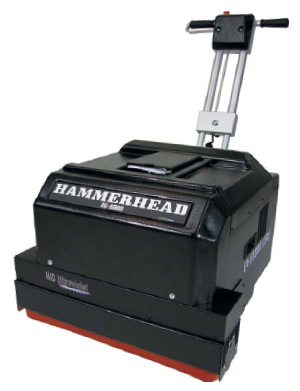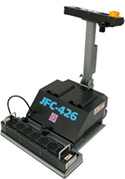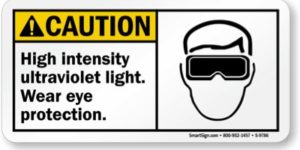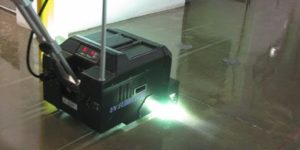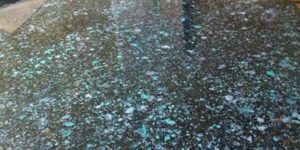For many years, UV-cured coatings (which cure when exposed to ultraviolet light) have been proven to be durable, reliable and long-lasting in factory settings. They are extensively used in manufacturing practically every type of product. Automobiles, airplanes, prefinished hardwood floors, furniture, cabinets, business cards, musical instruments, coated pipe, appliances and many more products are all coated with UV-curable coatings. These products are then exposed briefly to a powerful UV source, and the coating is instantly transformed from a liquid state to a solid state with physical properties that are superior to those of most other types of coating.
With the advent of specifically formulated site-applied UV-curable coatings and the availability of quality UV curing equipment, these benefits are now also available in the field to concrete contractors working on a wide variety of surfaces.
Portable UV curing equipment is largely divided into two categories based on the physical size of the machine. Floor models are larger, heavier, equipped with wheels and designed to be rolled over the surface to be cured. Hand-held models are smaller, lighter and are designed to be held over the surface to be cured.
Both types of equipment have a rectangular-shaped curing window that is directly under a UV lamp. The size of this window determines how much surface can be cured with each pass of the equipment. The larger this area, the more surface area can be cured in a single pass. The speed with which the UV equipment can pass over the surface is determined by the coating type, the amount of pigment in the coating, the thickness of the coating and the power output of the UV light source. For the best results, it is very important to always follow the application directions provided by the coating manufacturer.
Floor machines vary greatly in power and size from a few hundred watts up to 10,000 watts. The width of the area they can cure in a pass varies from 1 foot to 3 feet. Some of these machines feature a speed indicator, letting the operator know exactly how fast the machine is being pushed forward. This can be important for ensuring that the coating is cured to the manufacturer’s specifications – otherwise, there is a risk of premature failure of the coating, as well as of an incompletely cured surface that will be marred by foot traffic. Higher-end equipment is completely self-propelled, usually requiring the operator to merely enter a speed on a control panel and squeeze a trigger to ensure proper UV exposure.
Hand-held machines generally range in power from 250 watts to 1,800 watts with an effective curing width of up to 12 inches. These are used extensively when refinishing countertops, bathtubs, sinks, and so on, and they are also an essential part of the floor-coating toolbox for curing areas under stationary equipment, corners and stair treads. A hand-held unit is used everywhere a floor machine can’t be practically used.
The source of UV light is almost always a high-intensity discharge lamp. Such lamps must contain a metal to provide the UV light required. Iron and gallium are commonly used in other industries, but the standard for site-applied coating machinery is mercury. The core gas of the lamp is made up of argon or xenon, a difference that mainly impacts the start-up time of the machine. Most manufacturers that use argon lamps build in some form of mechanical shutter or holster to block the UV light during the warm-up period. Most machines that require a warm-up period also require a cool-down period before the UV lamp can be turned on again. Some manufacturers use continuous-wave xenon (CWX) lamps instead for instant starting and very rapid warm-up, requiring no shutter or cool-down/warm-up cycles between uses.
Safe usage is critical
It is essential for the operator of UV curing equipment to be trained in proper operating and safety procedures and for all personnel in the area while equipment is in use to be equipped with proper safety equipment. UV radiation can cause serious skin and eye damage if proper protective gear is not worn at all times.
Some hand-held equipment manufacturers include proximity sensors in their hand-helds to reduce unwanted exposure by disabling the light source when the machine is not close to a surface. Floor-curing equipment often contains safety-tilt sensors to disable the light source when the machine is tilted back to eliminate stray UV light. They also can be equipped with sensors to do the same when the machine is left motionless for too long, as the UV lamp operates at a very high temperature and can scorch floors if left on while stationary.
UV curing shows much promise for eliminating many of the problems and shortcomings that come with more conventional coatings, such as VOC emissions that keep people out of an area for a period of time after the coating is applied, long cure times, and wait times between recoat applications. Also, UV coatings can be considered a truly green technology due to their lack of emissions and the potential for immediately putting the coated surface back into use. Floor-curing equipment can cure a floor faster than a coating can be put down, and hand-held units allow the same advantages of these advanced coatings to benefit virtually any surface.
Usually, equipment manufacturers and coating formulators offer training on safety and application techniques. These resources should be utilized to ensure best results and safety when working with this versatile and capable technology.
